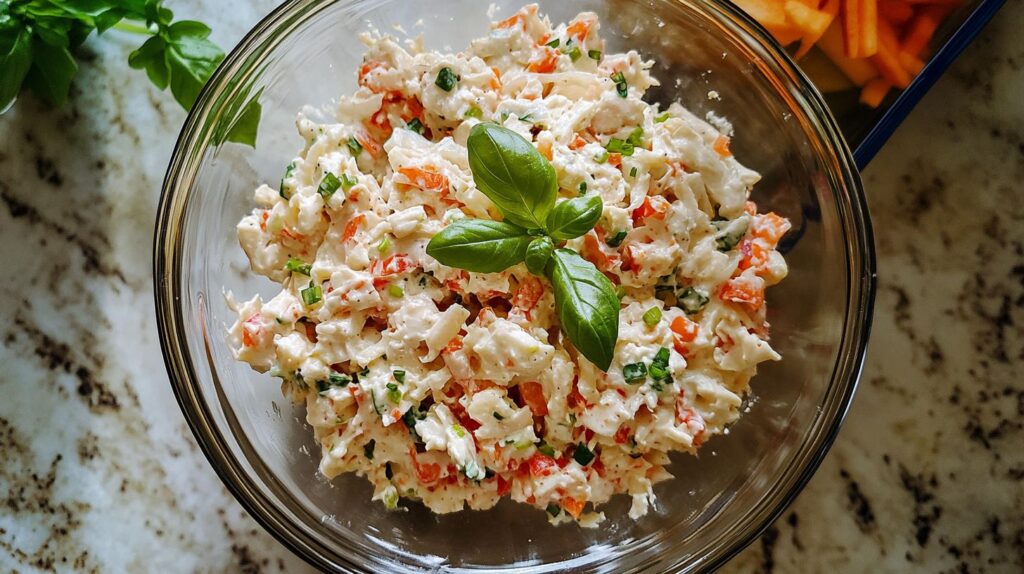Crab Salad Sushi: A Delicious Homemade Recipe
Learn how to make creamy crab salad sushi with simple ingredients, easy steps, and expert tips to create the perfect roll at home.
Making crab salad sushi at home may seem challenging, but it is simpler than you think. Indeed, this unique roll combines sweet crab meat with fluffy sushi rice. Consequently, it creates a creamy, savory, and refreshing bite. Moreover, by using the right techniques, you can craft rolls that taste as good as those from top sushi bars. Ultimately, these instructions will guide you through each step. Basically, you will learn about choosing ingredients, shaping rolls, and mastering textures. Furthermore, you will discover how to vary the flavors to match your personal tastes.
What Is Crab Salad Sushi?
Crab salad sushi refers to a sushi roll filled with a creamy mixture of crab, mayonnaise, and seasonings. Undoubtedly, this beloved roll has captured the hearts of sushi enthusiasts across the United States. Initially, many people associate sushi with raw fish, but crab salad sushi offers a gentle introduction. Comparatively, it provides a mild yet rich flavor. Chiefly, imitation crab often features in this roll, which simplifies preparation and reduces cost.
Furthermore, the dish usually includes seasoned sushi rice, nori sheets, and additional ingredients for crunch or sweetness. Particularly, avocado or cucumber often pairs with crab salad to give a balanced texture. Eventually, you can even add a hint of spice or citrus to brighten the flavors. Another reason for its popularity is that it accommodates different dietary preferences. Equally, you can tweak the filling to suit your palate or meet nutritional goals.
History and Origins
While crab salad sushi does not trace back to ancient Japan, it arose in response to Western palates. Afterward, sushi chefs in America started experimenting with non-traditional fillings. Consequently, crab, a familiar and widely available ingredient, was a natural choice. Indeed, it soon became a mainstay on many American sushi menus.
Popularity in the United States
In the U.S., sushi culture has expanded beyond traditional nigiri and sashimi. Thus, rolls like crab salad sushi enjoy steady popularity. Because it appeals to those new to sushi, it often appears on beginner-friendly sushi sampler platters. Eventually, this roll’s comforting flavors and textures help broaden sushi’s appeal to a wide audience.
Key Ingredients for the Perfect Crab Salad Sushi Roll
When making crab salad sushi, you need a handful of key ingredients. Basically, quality matters, so select premium sushi rice, fresh crab (or good-quality imitation crab), and reliable seasonings. Moreover, a balance of flavors ensures that each bite tastes delightful. Indeed, a successful roll depends on using the right rice, crab, nori, mayonnaise, and complementary additions.
Selecting the Crab for Crab Salad Sushi
To make crab salad sushi, choose between real crab meat or imitation crab sticks. Indeed, real crab provides delicate sweetness, but it can be expensive and harder to find. Conversely, imitation crab—made from pollock and flavorings—is affordable and consistent. Comparatively, it still offers a rich, crab-like taste that pairs well with sushi rice. Nevertheless, always ensure you buy fresh, high-quality crab or imitation crab to maintain purity of flavor.
Choosing Rice Varieties for Crab Salad Sushi
Undoubtedly, sushi rice is a cornerstone of perfect crab salad sushi. Ideally, use short-grain Japanese sushi rice. Consequently, this rice becomes sticky and slightly sweet once cooked and seasoned. Moreover, rinse the rice thoroughly before cooking to remove excess starch. Finally, season it with rice vinegar, sugar, and salt. Altogether, this creates a balanced canvas that highlights the creamy crab mixture.
Step-by-Step Guide to Making Homemade Crab Salad Sushi
Crafting crab salad sushi at home is straightforward if you follow each step carefully. Initially, gather your tools: a sushi mat, sharp knife, cutting board, and mixing bowls. Afterward, prepare the ingredients and organize them within reach. Consequently, this improves the rolling process and ensures uniform, neat results. Eventually, you will master these steps and gain confidence in your sushi-making skills.
Preparing the Ingredients and Seasonings
Begin by shredding your crab meat or slicing imitation crab sticks into thin strands. Next, combine the crab with Japanese mayonnaise, a pinch of salt, and a dash of lemon juice. Consequently, you create a creamy mixture that forms the heart of your crab salad sushi roll. Meanwhile, cook and season your sushi rice to perfection. Indeed, let it cool to room temperature for easier handling.
Additionally, cut vegetables like cucumber or avocado into thin strips. Comparatively, these fresh ingredients add crunch and balance to the roll. Furthermore, keep roasted nori sheets ready for rolling. Specifically, choose high-quality nori sheets for better flavor and structure.
Assembling and Shaping the Rolls
Place a sheet of nori on your sushi mat, shiny side down. Spread a thin, even layer of rice over the nori. Consequently, leave a small border at the top. Then, place a line of your crab salad mixture along the center, followed by cucumber and avocado slices. Eventually, lift the sushi mat’s bottom edge and roll it firmly. Do this while pressing gently to maintain shape.
Continue rolling until the nori encloses the filling. Afterward, apply gentle pressure to form a tight cylinder. Thus, you ensure the roll holds its shape. If you want an inside-out roll, flip the nori and rice sheet first before adding fillings.
Rolling the Ideal Crab Salad Sushi Roll
To achieve the ideal crab salad sushi roll, keep even pressure and maintain alignment. Furthermore, ensure the fillings are well-distributed for balanced flavor. Another tip is to moisten your knife before slicing the roll into bite-sized pieces. Consequently, you get clean cuts and minimize tearing. Finally, garnish with toasted sesame seeds or a drizzle of spicy mayo if desired.

Exploring Flavor Variations and Customizations
While classic crab salad sushi is delicious, consider enhancing it with creative variations. Comparatively, you can introduce extra ingredients, sauces, and textures to keep things interesting. Especially if you enjoy experimenting, these customizations allow you to transform a simple roll into something extraordinary.
Mixing in Fresh Vegetables
Add crisp vegetables like julienned carrots, bell peppers, or radishes. Consequently, these vegetables provide refreshing crunch and color contrast. Likewise, thin asparagus spears or microgreens bring a delicate snap and subtle flavor. Meanwhile, pickled ginger or daikon radish can add brightness and tang.
Adding Creamy Sauces and Spicy Toppings
Introduce spicy mayo, sriracha, or wasabi-infused mayonnaise for extra heat. Accordingly, the heat contrasts nicely with the creamy crab mixture. Indeed, a sprinkle of chili flakes or togarashi seasoning can also offer subtle warmth. Conversely, try a sweet eel sauce drizzle for a rich, caramelized note. Ultimately, these additions reflect your personal preference and help craft a signature version of crab salad sushi.
Serving, Storing, and Pairing Your Rolls
Presenting and preserving crab salad sushi correctly affects flavor and quality. Essentially, sushi tastes best when fresh, so serve it promptly for maximum enjoyment. Nevertheless, if you must store leftovers, proper techniques maintain freshness and prevent sogginess.
Serving Suggestions and Presentation
Place your sliced crab salad sushi rolls on a clean, attractive platter. Consequently, garnish with pickled ginger, wasabi, and soy sauce on the side. Furthermore, use contrasting colors and textures to make your plate visually appealing. For example, adding a sprinkling of sesame seeds or finely chopped herbs can elevate the dish’s appearance. Additionally, serve with miso soup or a small green salad for a complete meal.
Proper Storage Techniques
If you have leftovers, wrap them tightly in plastic wrap and refrigerate for no more than a day. However, note that sushi rice may harden and lose its perfect texture. Thus, it is best to enjoy crab salad sushi fresh. Eventually, if refrigerated, allow it to sit at room temperature for a few minutes before eating. Ultimately, fresh preparation and immediate consumption ensure the best taste and texture.
Health Benefits and Nutritional Considerations
Crab salad sushi can fit into a balanced diet. Undoubtedly, it provides lean protein and essential nutrients. However, consider portion sizes and additional ingredients, since mayonnaise and sauces add calories. Nonetheless, these rolls can be part of a healthy lifestyle with moderation.
Nutrient Profile of Crab
Crab, whether real or imitation, contains protein and essential minerals. Specifically, it offers nutrients like selenium, vitamin B12, and zinc. Meanwhile, real crab tends to have fewer additives, whereas imitation crab provides a budget-friendly option. Consequently, either choice can work, depending on your goals and priorities.
Balancing Carbs, Protein, and Fats
Sushi rice provides complex carbohydrates. Meanwhile, crab and any added vegetables contribute protein and micronutrients. Mayonnaise and sauces add fats for flavor and creaminess. Therefore, crab salad sushi can deliver a balanced macronutrient profile. Moreover, pairing your sushi with a light soup or side salad ensures a more complete meal.
Common Mistakes and Troubleshooting Tips
If your first attempts at crab salad sushi do not turn out perfect, do not worry. Eventually, practice improves your technique. Additionally, recognizing common mistakes helps you refine your skills. Consequently, you will gain confidence and produce rolls that impress family and friends.
Avoiding Soggy Rice
Overly wet rice can ruin the texture of your crab salad sushi. Therefore, rinse the rice thoroughly before cooking. Equally, measure your water carefully and follow proper cooking times. Consequently, your rice will be fluffy and slightly sticky, but never mushy.
Adjusting Seasonings and Textures
If your sushi lacks flavor, add more vinegar or sugar to the rice seasoning. Conversely, if the crab salad tastes too bland, mix in a pinch of salt or a splash of soy sauce. Meanwhile, if your roll falls apart, tighten your rolling technique. Basically, minor adjustments lead to significant improvements in taste and appearance.
Frequently Asked Questions About Crab Salad Sushi
What is crab salad in sushi made of?
Crab salad sushi filling typically includes imitation or real crab meat, mayonnaise, and seasonings. Consequently, chefs may add lemon juice, salt, or spices. Therefore, this creamy mixture forms the core of the roll. Comparatively, avocado or cucumber often complements the crab salad.
What is crab salad made of?
Crab salad usually contains shredded crab meat, mayonnaise, and flavor enhancers. Undoubtedly, lemon juice, salt, and sometimes a hint of sugar are common. Moreover, herbs, scallions, or chives add freshness. Eventually, this mixture can be adjusted to taste and used in various dishes.
What is the shredded crab on top of sushi called?
Often, shredded crab or imitation crab on sushi is referred to simply as “crab sticks” or “kani.” Basically, kani is the Japanese term for crab. Consequently, when finely shredded, it is sometimes called “kani salad.” This topping adds a sweet, briny taste that contrasts well with rice and nori.
Is crab salad healthy?
Crab salad can be part of a balanced diet. However, the mayonnaise adds fat and calories. Therefore, enjoy it in moderation or use lighter dressings. Basically, pairing it with vegetables and watching portion sizes ensures a healthy meal. Eventually, this helps maintain a balanced approach to eating.
Conclusion:
In conclusion, crab salad sushi offers an approachable and flavorful entry point into the world of sushi-making. Its creamy, savory filling blends beautifully with seasoned rice, crisp vegetables, and delicate nori. By selecting fresh ingredients, practicing proper rolling techniques, and experimenting with sauces and garnishes, you can easily recreate the taste and texture of restaurant-quality rolls at home. Whether you prefer the subtle sweetness of imitation crab or the authentic flavor of real crab meat, this roll allows endless customization to match your personal preferences. Ultimately, making crab salad sushi at home not only expands your culinary skills but also rewards you with a delicious, shareable dish that can impress family, friends, and newcomers to sushi alike.

